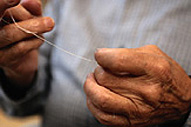5 tips for keeping your mouth healthy, white and bright between cleanings
Twice yearly dental visits are an important part of your overall healthcare regimen, and how you take care of your teeth and gums will set you on the right course for better check-ups. Here are some tips for what you can do between dental visits to keep your mouth healthy and your
smile pearly white.

1. Healthy eats mean healthy teeth
A well-balanced diet that is rich in fruits and vegetables will help keep your body and mouth healthy. “High fiber, crunchy foods scrub your teeth and stimulate saliva,” says international speaker and registered dental hygienist, Cindy Kleiman. Carrots, celery and broccoli are foods that can act as natural abrasives. They are also better for your overall health than foods high in refined sugars, which have low nutritional value.
Eating healthy also includes drinking more water. Soft drinks, sports drinks and flavored coffee creamers contain high amounts of sugar, which can lead to cavities. “Even diet sodas contain carbonic acid, which erodes teeth enamel,” explains Kleiman. Replacing carbonated beverages that are high in sugar with healthier alternatives, like no-sugar-added juices and water, will be beneficial to your teeth, as well as to your waistline.

2. It’s just as much about timing as it is about technique
Brushing your teeth at least twice a day for a full two minutes is necessary to maintain healthy teeth and gums. Timing isn’t everything though; technique also plays a role. When brushing, tilt the brush at a 45-degree angle to massage the gums and to remove plaque and bacteria that can lead to decay.
According to Dr. Mark E. Hyman, renowned speaker, educator and practicing dentist, using a power toothbrush can make a “staggering difference in how well you clean your teeth” A power toothbrush can also take the guesswork out of technique and timing. One that Dr.Hyman recommends is the new Philips
Sonicare FlexCare Platinum, which has an intuitive Pressure Sensor to help guide proper brushing technique, in addition to a built-in SmartTimer that helps you reach the optimal two-minute cleaning. It has also been proven to remove up to
seven times more plaque between teeth than a manual toothbrush.*

3. Flush with fluoride
Historically, science has shown that fluoride has contributed to the prevention of tooth decay. There are multiple ways to add fluoride into your at-home oral care regimen, including using toothpaste with fluoride and a fluoride rinse on a regular basis. Also, drink tap water, as most city water systems add fluoride to the water.

4. Clean between
Cleaning your teeth means more than brushing the surfaces; it also means doing what you can to remove food particles and bacteria from the areas between your teeth. According to Kleiman, a high percentage of dental decay occurs between teeth. “Using dental floss, an interdental pick or other tools, such as
Philips SonicareAirFloss—which uses quick bursts of air and water droplets to remove plaque—can help prevent gum disease,” says Kleiman.
Gum disease has been linked to other serious health problems, such as diabetes, heart disease and Alzheimer’s. “Cleaning between your teeth daily keeps your breath fresh, prevents tooth decay and is important for your overall health,” explains Dr. Hyman.

5. Keep your mouth in check
In between dental visits, Kleiman suggests that you monitor the health of your teeth and gums by examining them yourself. “We each have a personal responsibility to monitor our own health,” she says. Be proactive. Look for any changes in the appearance of your gums, shifting of your teeth and never ignore oral pain. If you notice any abnormalities, call your dental professional right away and book an appointment. “Early detection is the key,” notes Dr. Hyman.
Serving Waukesha, Oconomowoc, and Hartland Wisconsin, Bailey Family Dental is most concerned with your comfort. Drs Terese and Richard Bailey and their friendly staff will explain treatment options and give estimates before you begin your treatments. To learn more, feel free to go to our website at www.bailyfamilydental.com, or call us at 262-369-8633. Our office is located at 557 Cottonwood avenue, Hartland Wisconsin.
































